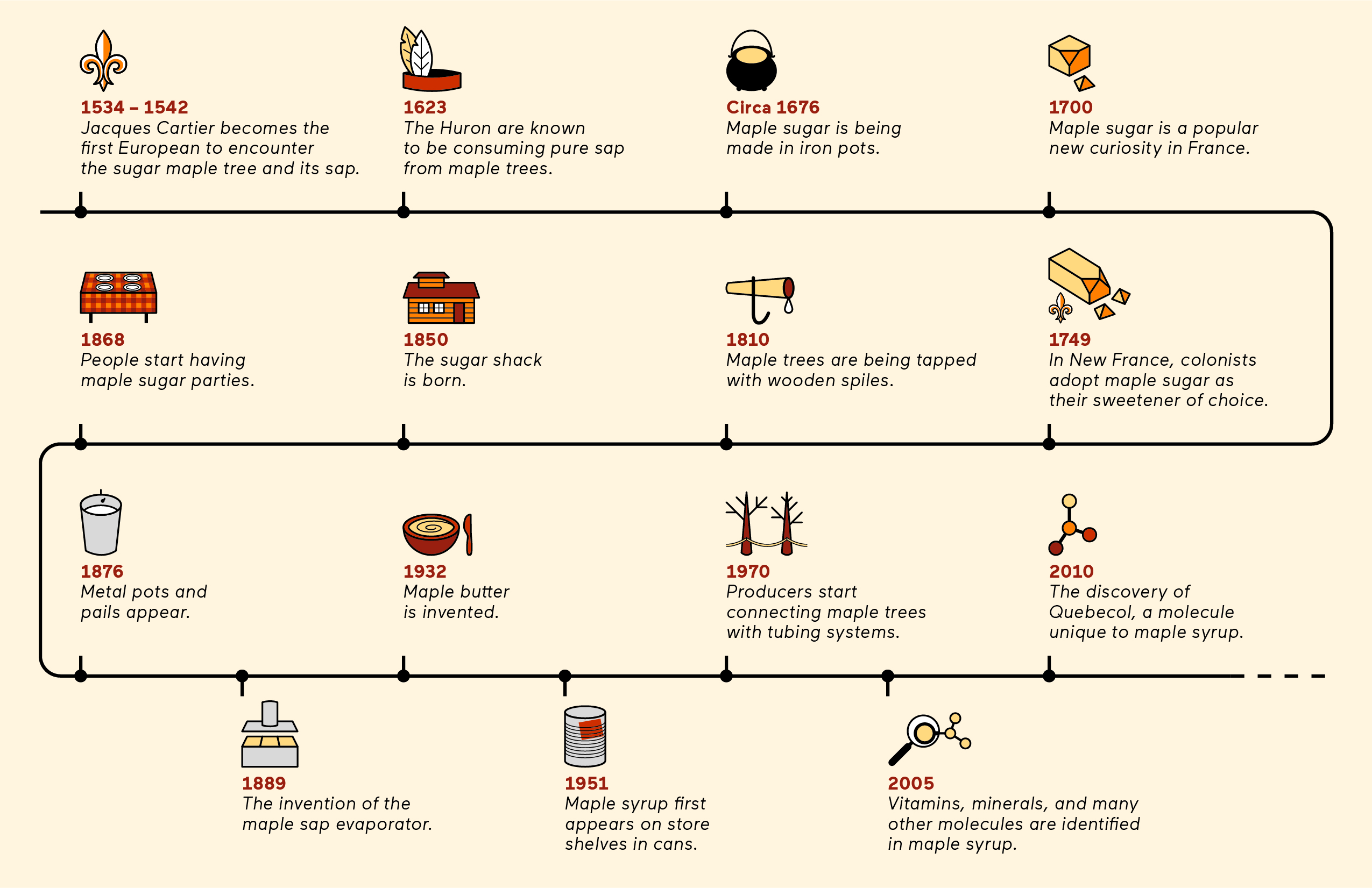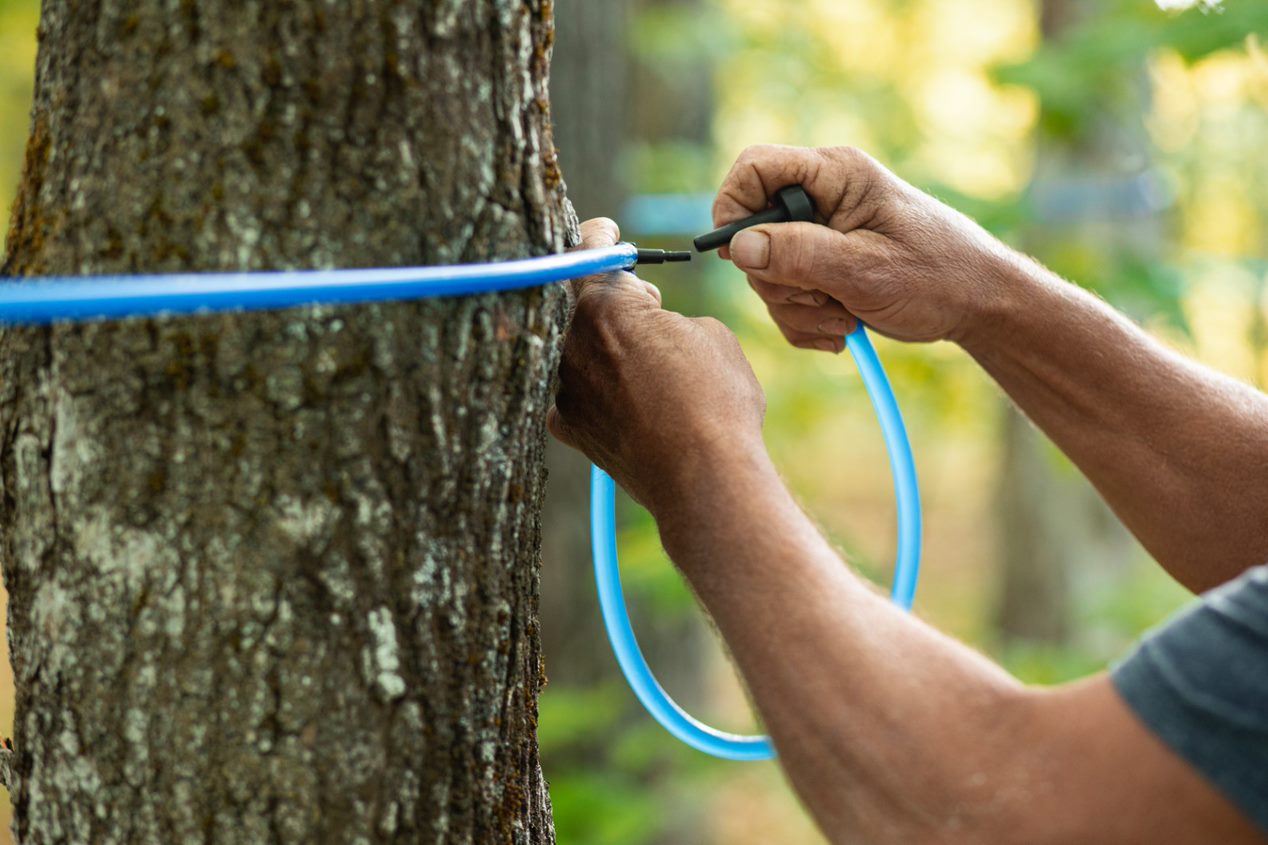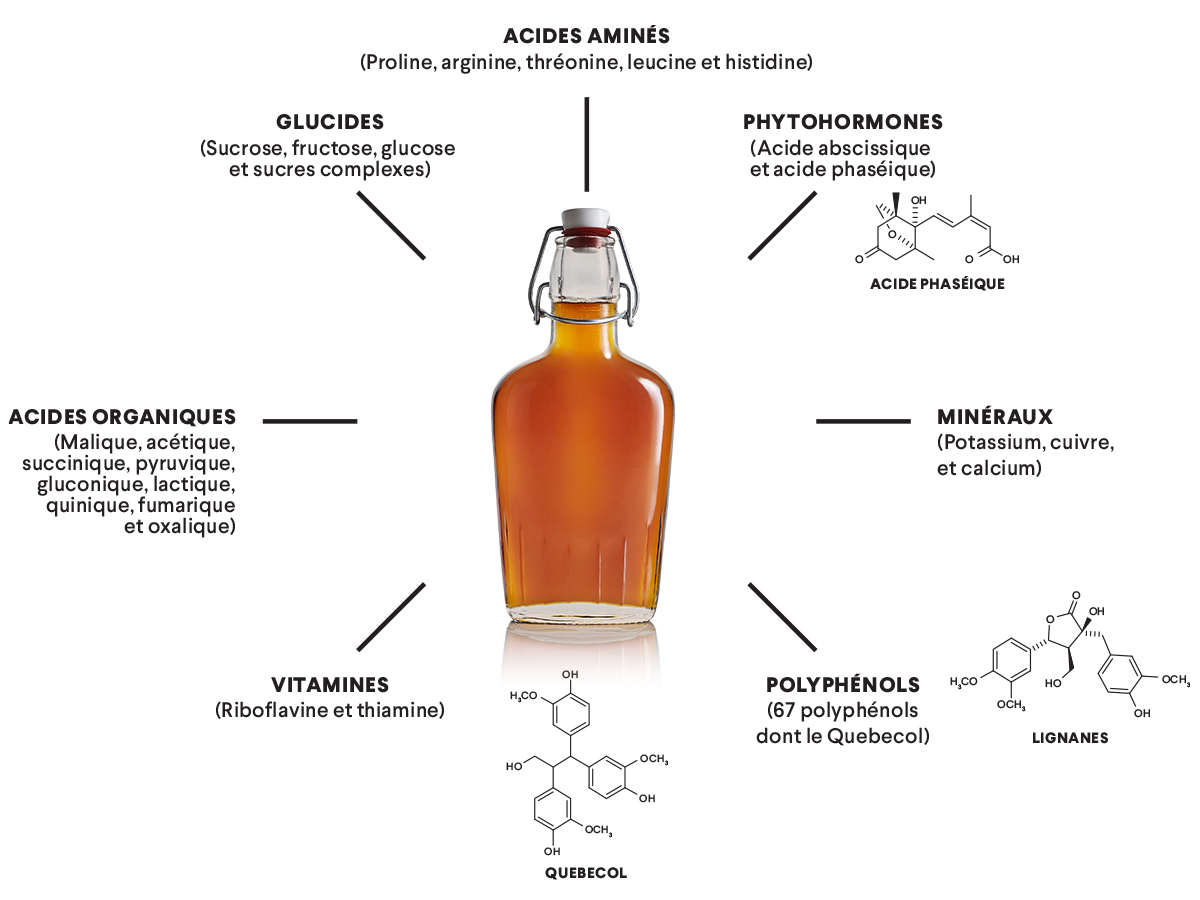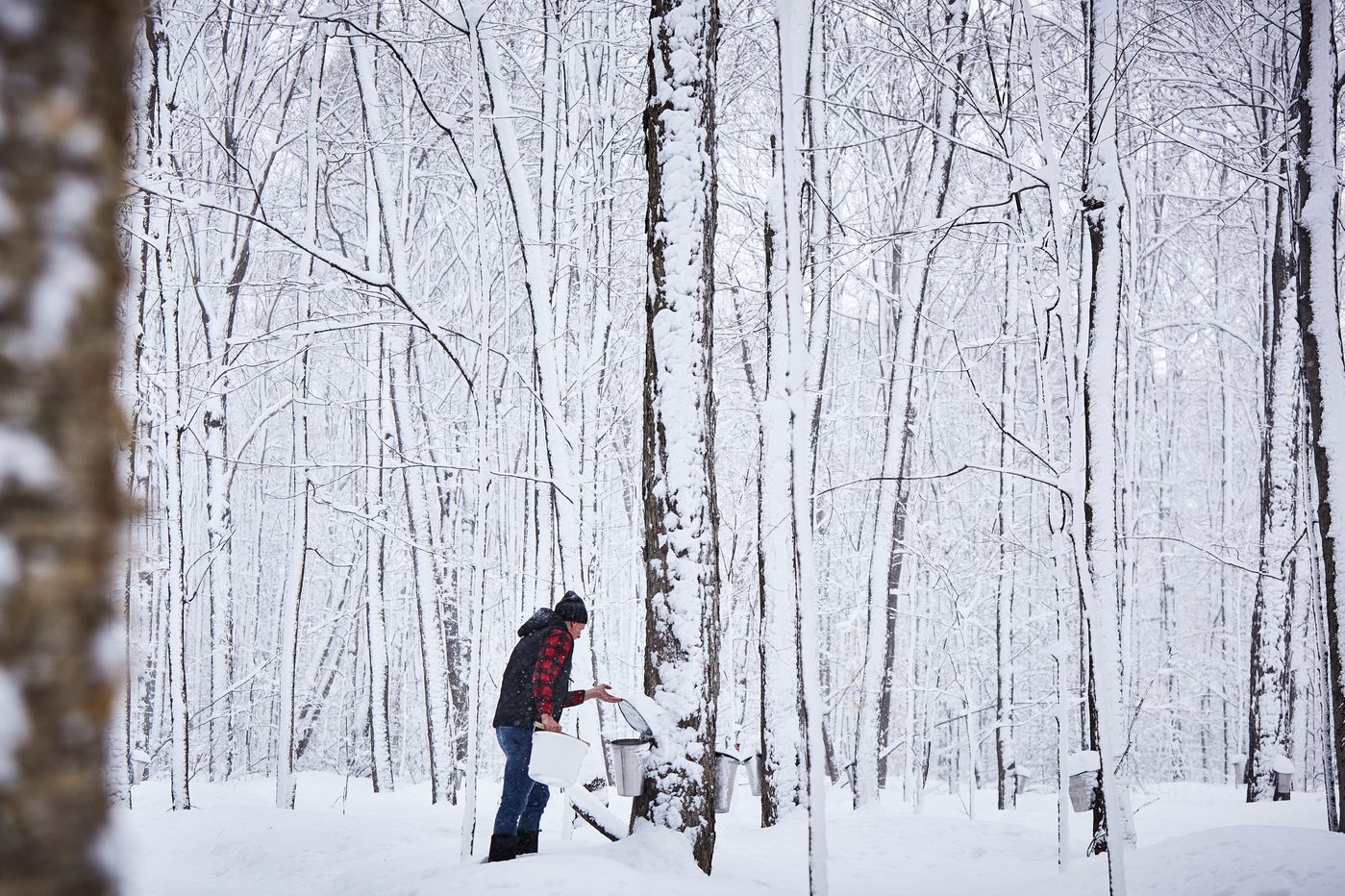History of Maple Syrup
PAST, PRESENT AND FUTURE
Rich not only in taste but also in history, maple syrup has led a fascinating existence through the centuries.
First discovered several hundred years ago, maple syrup has gone on to become one of the world’s most sought-after sweeteners.
But what is the origin story of maple syrup? And how did it become so popular all around the world? Read on to learn more about the history of maple syrup!
The origins of maple syrup
Historical sources reveal that maple syrup was officially discovered by Europeans for the first time sometime between 1536 and 1542.
Its exact origins are unknown, but it’s believed that Native Americans were consuming the food long before the arrival of European settlers.
The discovery of maple sap by Jacques Cartier and his fellow explorers in the 16th century was met with wonder.
After chopping down what they believed to be a large walnut tree, the intrepid explorers discovered a strange liquid flowing out from the trunk and branches.
The tree wasn’t really a walnut tree, but a sugar maple – and the strange liquid was maple sap. After tasting it, the explorers compared it to a good wine.
The next first-hand report of maple syrup comes from Marc Lescarbot, who bore witness to the ‘distillation’ of maple sap into maple syrup during a trip to Acadia in 1606.
European migration to the New World picked up in the years that followed, sparking even more interest in the special sap being used to produce sugar and syrup.
In these early years, it was maple sugar (rather than maple syrup) that was the most popular and widely known maple product.
A global delicacy
Maple sugar continued to grow in popularity during the early 1600s and was soon being exported around the world as a culinary curiosity.
Around this time, maple syrup producers also learnt how to make maple sugar, and in the second half of the 17th century there are growing references to the export of maple sugar to France.
King Louis XIV was known to be a big fan of maple sugar candy, while maple sugar was noted as being widely consumed in France by Swedish biologist Pehr Kalm in 1749.
This coincides with a rise in demand for sugar products across Europe, with maple sugar used as an alternative to refined sugar derived from sugarcane.

Scientific interest
Some of the first records and observations of the maple tapping process were also made in the 18th century.
While on a visit to Acadia in 1709, Sieur de Dièreville described how farmers would make a small incision in the tree and then insert a trough-shaped piece of wood ready to capture the sap.
Over in New England, Paul Dudley wrote a book on the making of maple sugar from what he described as “maple sugar juice”.
French writers Pierre-François-Xavier de Charlevoix, Monseigneur de la Barre and Joseph-François Lafitau added to this growing body of research, noting the use of iron pots to make maple sugar.
Maple syrup came to mainstream attention when the works of renowned scientists Pehr Kalm and Henri-Louis Duhamel du Monceau were published by the Royal Academy of France.
French philosopher Denis Diderot also wrote about the sugar maple tree and the making of maple sugar in his esteemed work Encyclopedia, or a Systematic Dictionary of the Sciences, Arts and Crafts.
These writers took a holistic approach to explaining the natural processes that occur in sugar maple trees and were also some of the first to consider the potential health benefits of maple syrup.
Advancements in production
New production methods introduced in the 19th century, made available by breakthroughs in electrical engineering, saw yields increase dramatically.
Rather than using an axe, incisions were made with a drill. The iron pot that repeatedly had to be taken on and off the fire was replaced with an evaporator.
This was also the time when the iconic sugar shacks began to spring up in maple forests across Canada.
The extra facilities provided by sugar shacks, which were proper buildings designed for boiling maple sap into maple syrup, helped producers expand.
Production slowly evolved into the model we see today. It wasn’t until the early 1930s that maple spread was made for the first time and proper perseveration of maple syrup became the norm.
This was one of the factors that saw maple syrup become the most popular maple product on the market ahead of maple sugar.
Other important moments in the second half of the 20th century include the introduction of tubing systems in the 1970s and reverse osmosis in the 1980s.

Learn more about the maple syrup production process below.
The maple syrup grading system
Maple syrup products were first classified into categories in the 1920s, paving the way for better standards across the maple industry.
In 2016, the Canadian government introduced a new grading system which divided the highest-grade maple syrup into four groups – golden, amber, dark and very dark – based on colour and flavour.
The lighter grades, which are produced at the start of the sugaring season, have a more delicate taste, while the darker grades from the end of the harvest are more pronounced in flavour.
The grading system has helped raise awareness of maple syrup’s impressive versatility, with the lighter grades generally used as a topping and the darker grades more suited to sauces, marinades and baking.

Learn more about the maple grading system below.
Research and innovation
The 21st century brought new product innovations like maple water, maple vinegar and maple flakes, helping to expand the many uses of maple products even further.
Ongoing research into the chemical properties of maple sap has also led to a number of interesting discoveries.
In 2011, a group of scientists discovered a new polyphenolic molecule that was unique to maple syrup in the natural world. It was named Quebecol, after the Canadian province synonymous with maple syrup.
More recent studies have found that Quebecol – as well as more than 20 other compounds naturally present within maple sap – have antioxidant properties.
Testing the effects of replacing table sugar with maple syrup, a landmark study from 2023 found that maple syrup led to better health outcomes for participants.

Learn more about the health benefits of maple syrup below.
The future of maple syrup
Maple syrup is now more popular than ever, with Quebec exporting maple syrup and other maple products to more than 50 countries around the world.
While the demand for maple syrup continues to climb, maple syrup producers face a new challenge in the form of climate change.
The industry has already begun to adapt by adopting new technologies, which are helping to offset losses from extreme weather events and shorter tapping seasons.
Quebec Maple Syrup Producers also has a strategic reserve of maple syrup spanning 267,000 sq ft for use in the event of production shortfalls.
Maple syrup is itself an incredibly sustainable food with a net-positive impact on the environment. Maple forests in Quebec capture around eight times the amount of carbon emitted during the production process.
As climate change worsens, natural products like maple syrup will play an important role in decarbonising the food industry, providing consumers with a more sustainable alternative to food sources that have a detrimental impact on the environment.

Learn more about the sustainability credentials of maple syrup below.
A truly unique product
From its early origins through to being exported all around the world, maple syrup has captured the imagination of everyone who has had a chance to taste its sweet, unique flavour.
And with research continuing to uncover fascinating new findings about the natural sweetener, the future of maple syrup promises to be just as bright as its past.
Has all this talk of maple syrup whet your appetite? Check out our range of maple syrup recipes to learn more about the versatility of this one-of-a-kind product.
Hundreds of Delicious Recipes
Maple is a special addition to any recipe, from appetiser to dessert. Find one that’s perfect for you!
